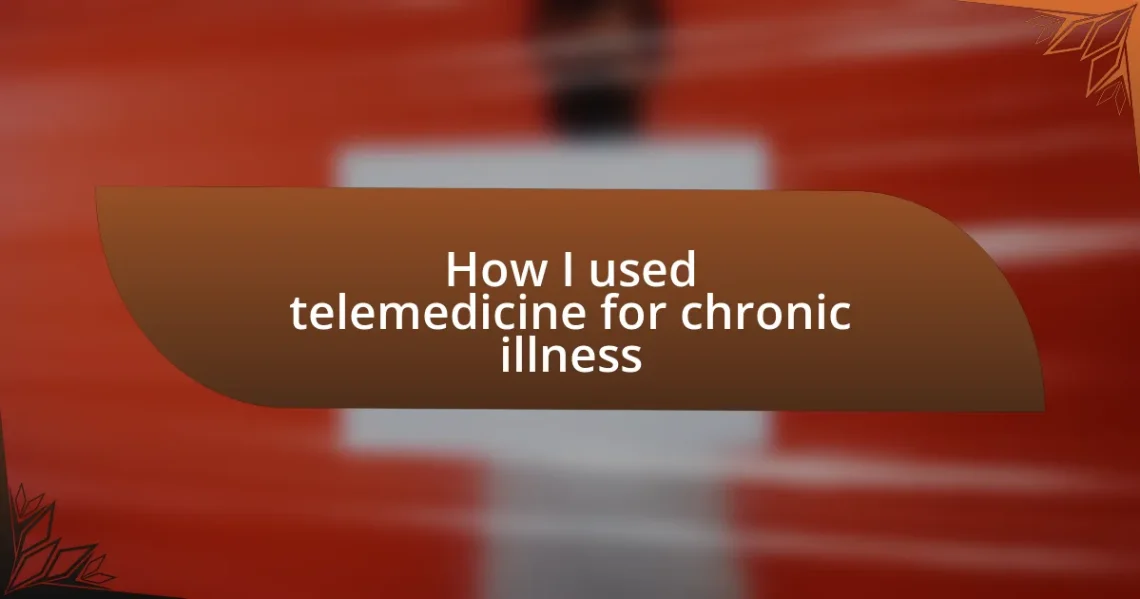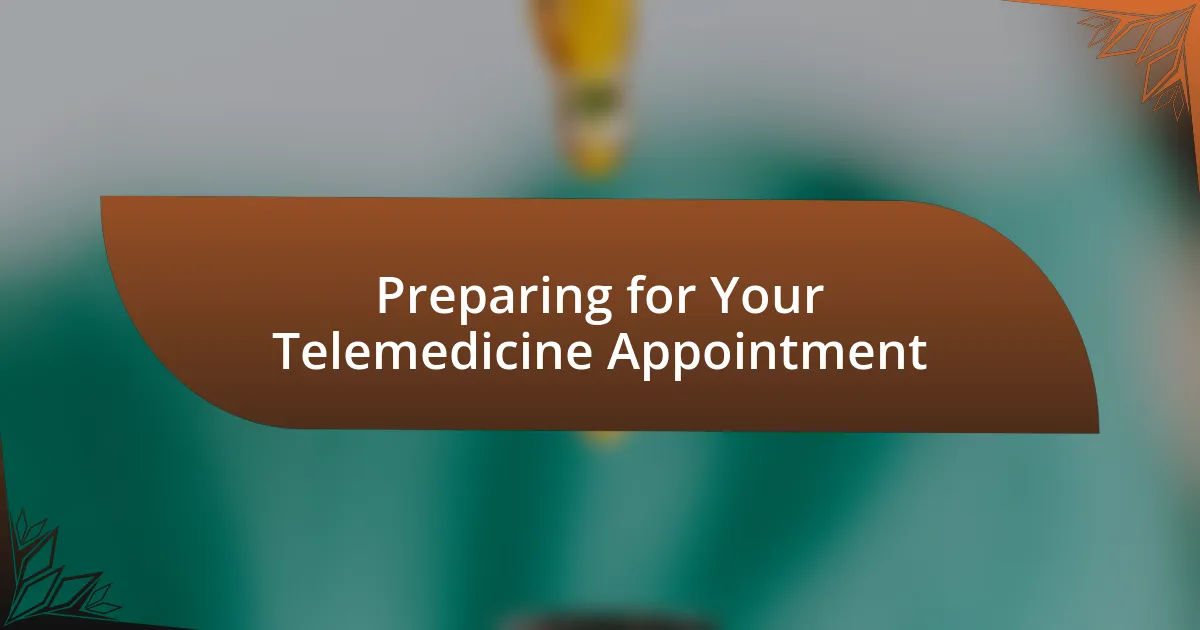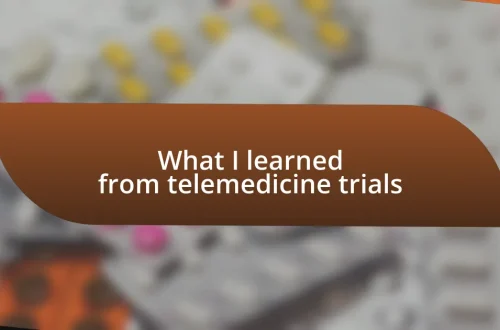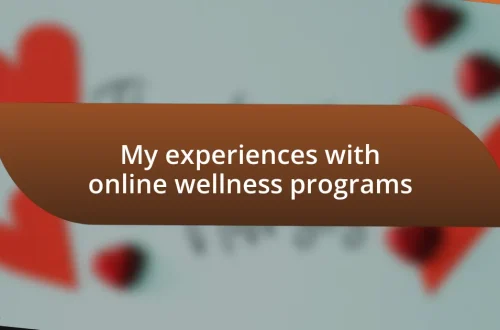
How I used telemedicine for chronic illness
Key takeaways:
- Telemedicine enhances healthcare access by providing convenience, ensuring consistency of care, and enabling specialist consultations without travel.
- Choosing the right telemedicine platform is crucial; prioritize user-friendliness, available services, and cost-effectiveness.
- Effective communication during appointments involves active listening, asking follow-up questions, and preparing thoroughly to enhance understanding and care quality.
- Challenges such as technology issues and the impersonal nature of virtual visits can be mitigated through open communication and emotional sharing to strengthen the provider-patient relationship.

Understanding Telemedicine Benefits
Telemedicine has truly transformed the way we think about healthcare access. When I was struggling with a chronic illness, the convenience of seeing my doctor from home felt like a lifeline. I didn’t have to worry about transportation or long waits in a clinic, and that relief alone made a significant difference in my mental well-being.
One key benefit I’ve found is the consistency of care. I could schedule regular follow-ups without the burden of travel, allowing me to maintain a sense of routine in managing my health. It made me wonder—how many others could find the same peace of mind with this approach? The ability to communicate with my healthcare team more frequently led to better adjustments in my treatment plan, which is something I never took for granted.
Additionally, telemedicine has opened up a world of specialist consultations that were once out of reach for me. I vividly recall my first video appointment with a specialist in another state; it felt empowering to have access to expert opinions without the hassle of travel. It made me appreciate how technology could bridge gaps and provide solutions that are simply not possible in traditional settings.

Choosing the Right Telemedicine Platform
Choosing the right telemedicine platform can significantly impact your experience, especially when managing a chronic illness. I remember the first time I explored various options; I felt overwhelmed by the number of platforms available. It helped to focus on what features were essential for my needs, such as user-friendliness, privacy, and seamless communication with my healthcare provider.
Another critical factor was the availability of specific services related to my condition. Some platforms offered specialized care that addressed my particular challenges, while others did not. For instance, I found that selecting a platform that allowed for both video and messaging options gave me more flexibility in how I could communicate with my doctor. I could quickly send updates and ask questions without waiting for our next scheduled appointment. It was like having support at my fingertips, which eased my anxiety about managing my health on a daily basis.
Lastly, I also considered the cost and insurance compatibility. It surprised me how some platforms offered affordable options without compromising on quality of care. As someone who has navigated insurance complexities due to my chronic condition, finding a platform that optimized both accessibility and affordability was a true game-changer. It made me realize that investing time in research now leads to better health management down the line.
| Platform Name | Key Features |
|---|---|
| Platform A | User-friendly, specialist services |
| Platform B | Video and messaging options, high security |
| Platform C | Affordable, insurance compatibility |

Preparing for Your Telemedicine Appointment
Preparing for a telemedicine appointment can feel daunting at first, but with a little organization, it can also be empowering. I vividly recall my initial experience; I was nervous and unsure about how to make the most of my time with the doctor. To help me prepare, I found that creating a specific checklist was immensely helpful. This practice allowed me to approach the appointment with confidence, knowing I had everything I needed at hand.
Here are some essential steps to consider before your appointment:
- Ensure your technology is working properly (e.g., check your internet connection and video/audio settings).
- Gather your medical history, including medications and recent lab results.
- Write down your symptoms and any questions you want to ask.
- Create a quiet and comfortable space for the appointment, free from distractions.
- Have a notepad ready for jotting down important notes or instructions during the call.
Taking these steps significantly reduced my anxiety and allowed me to focus on what truly mattered: the conversation about my health. I discovered that being prepared not only benefits my understanding of my condition but also fosters a better relationship with my healthcare provider.

Communicating Effectively with Your Provider
Effective communication with your provider during a telemedicine appointment is crucial for addressing your chronic illness. I remember a time when I felt overwhelmed trying to explain my symptoms over video. I realized that speaking calmly and articulating my concerns clearly made a significant difference; it allowed my doctor to understand my situation better and recommend tailored solutions.
One strategy that worked for me is to practice active listening. Sometimes, I found myself getting anxious and wanting to interrupt, but I learned that letting my provider finish their thoughts helped me catch vital information. It made me wonder—how often do we miss key details because we’re too eager to speak? Engaging completely with what the physician says has improved my comprehension and allowed me to ask more focused questions.
Finally, don’t underestimate the power of follow-up questions. After my doctor explained a treatment plan, I always asked additional questions to clarify any uncertainties. This approach not only deepened my understanding but also made me feel more involved in my care. I often thought, am I doing enough to advocate for myself? By pursuing clarity in our conversations, I strengthened my relationship with my provider and took charge of my health journey.

Managing Medications through Telemedicine
Managing medications through telemedicine has transformed my approach to treatment. I vividly recall a session where my doctor and I reviewed my medication regimen in real-time. By sharing my experiences with side effects via the telemedicine platform, we promptly adjusted my prescriptions, leading to improvements that I hadn’t thought possible.
There were moments when I feared that my medications were mismatched with my symptoms, and bringing that up in a virtual meeting felt less intimidating than in person. It struck me that telemedicine allowed for a more relaxed environment, making discussions about these sensitive topics easier. How often do we hesitate to voice our concerns in a traditional office setting? I found that having the ability to communicate openly from my own space encouraged a more transparent dialogue.
Moreover, leveraging the technology allowed me to set reminders through my health app for medication times and tracking my adherence. Each reminder felt like a little nudge, keeping me accountable and engaged in my therapeutic journey. Have we all considered how technology can support our health in ways we might not have realized? For me, this blend of telemedicine and tech turned medication management from a chore into an integral part of my daily routine.

Tracking Progress and Follow-Up
Tracking my progress through telemedicine has been a game-changer. After each appointment, I felt a sense of accomplishment as I reflected on what I had achieved since our last visit. It was refreshing to see tangible evidence of improvement, whether it was through symptoms subsiding or lab results showing progress. Do you remember the last time you felt a shift in your treatment? For me, it was empowering to see the direct correlation between my adherence to the medication and the positive feedback from my healthcare team.
Follow-up appointments became less daunting when I realized I could prepare beforehand with data from my health app. I began logging my symptoms daily, which gave me a clearer picture of my health fluctuations. This practice not only enabled me to present more accurate information during our discussions, but it also made me feel more in control. Isn’t it fascinating how having that data available can influence the direction of your care? I learned that proactive tracking leads to more personalized and effective follow-up strategies.
Additionally, the convenience of telemedicine meant I was more likely to stick to my follow-up schedule. I remember a time when I missed a couple of in-person appointments due to scheduling conflicts. With telehealth, I could easily find time in my day, even when life got hectic. This accessibility significantly improved my consistency in follow-ups, which I know has had a lasting impact on my overall health management. Have you ever experienced that feeling of dread over missing an appointment? With telemedicine, instead of that anxiety, I had a sense of relief knowing I could still connect with my doctor whenever I needed.

Overcoming Challenges in Telemedicine Use
Despite the many advantages of telemedicine, I encountered challenges that required a bit of ingenuity to overcome. For instance, the technology itself can sometimes feel intimidating. I vividly remember one appointment where my video connection was shaky, and I found myself fumbling with the app. In that moment, the frustration nearly overshadowed the benefits, but I decided to take a deep breath and troubleshoot with my healthcare provider. It made me realize that being open about technical difficulties could foster understanding and patience on both ends.
Another issue was the impersonal nature of virtual visits. I initially missed the warmth of face-to-face interactions and felt a disconnect. To combat this, I started preparing for my appointments differently. I made it a point to jot down not just my symptoms, but also my emotional state. Sharing these insights during video calls helped bridge the gap and made my doctor more attuned to my overall well-being. Have you ever felt that a digital interaction was lacking something essential? In my experience, incorporating personal reflections into the conversation can significantly enrich the encounter.
Finally, I learned to navigate the complexities of insurance and telemedicine billing. It can get quite overwhelming, and there were moments when I questioned whether I was getting the care I needed. I recall spending hours on hold with my insurer, and it was truly disheartening. However, I discovered that being persistent and asking clear questions about coverage was vital. This experience ultimately empowered me to advocate for my health, reminding me that my voice matters in the telehealth landscape. Isn’t it rewarding when we find ways to overcome such obstacles?




